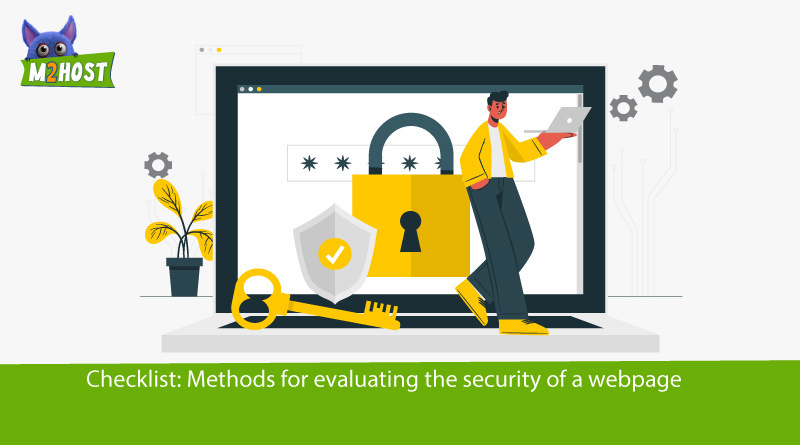Placing a website safety checklist on the internet exposes it to the possibility of being hacked, having its ports scanned, traffic monitored, and information mined. You could obtain some genuine visitors if you’re lucky in the website safety checklist, but if anyone debases or takes down your website safety site, you won’t get any valid visitors at all, so you need to do a website safety checklist. However, this is simply the tip of the iceberg in terms of what could be done to ensure the safety of a web application. The vast majority of internet users are aware that they must check for a locked icon whenever they are surfing the internet. Although SSL could be implemented in a variety of methods, some of which are far more effective than others in the website safety checklist. Cookies are used to retain critical data from web pages; ensuring the safety of these data could help avoid impersonators. Furthermore, by configuring a few settings on your webpage, you may secure it from both manual & automatic forms of online assault, thereby preventing the data of your consumers from being compromised. The following are some methods that may be taken to strengthen your website safety and significantly improve the resilience of your web application.
Confirm sitewide SSL for website safety
If you see a padlock in the address bar of your laptop, it should indicate that the website you are currently visiting is safe, correct? What it signifies, in reality, is that you are presently connected to the website via an SSL connection. SSL shouldn’t be an article option that throws the customer back & forth among secured and decrypted networks in order to take full benefit of SSL & validate strong encryption for website safety. Instead, SSL should be enabled across the entire page & must mandate website safety. Each and every page ought to be accessible only via SSL for website safety. Data that is sent via connections that are not encrypted with SSL is sent in plain text, which makes it easy for anyone who is prepared to put in the effort to read it. The website safety of the whole website could be compromised by a simple feature containing critical data or a login input on the left that is not secured.
Check if the Certificate authority is valid for website safety
When will your Certificate authority lapse? If you are aware of the responses to these queries, you won’t have to worry about the time and effort for website safety. Users put into instituting SSL being squandered because you failed to notice that the credential was going to expire or about your site creating trouble for your clients for website safety because they received pop-up warnings about it. A process that alerts the appropriate stakeholders when the certification is getting close to its deadline should be put into place so that the certificate does not become invalid for website safety. The vast majority of large certificate suppliers are immediately recognized in all major browsers; nonetheless, it’s usually a good idea to double-check that the company from which you acquire your certifications is up to date on the many security upgrades that computer makers are promoting. When significant changes occur like this for website safety, website managers are required to re-issue any certificates that are impacted and/or update the settings of their systems.
Employ data that are only accessible through HTTP for website safety
When cookies are protected, the data that your website keeps on the computers of visitors remains secret & can be accessed by an imposter for website safety. This prevents the data from being misused. Cookies with the HTTP Only attribute limit accessibility to the cookies themselves, preventing customer programs & pass programming vulnerabilities from exploiting cached data. It is recommended that this be set so that more recent web computers which support Http only could benefit from enhanced website safety. Traditional cookies would continue to be delivered to visitors whose computers do not recognize the new cookie format.
Make use of encrypted cookies for website safety
Cookies that meet the criteria for being considered to be secure can only be sent via an HTTP server. This protects cookies that may contain highly critical data from being read while they are traveling from the site to the client. In the event that secured cookies are not used, a third party may be able to steal a cookie that has been delivered to a client and pose as that used when communicating with a web server for website safety. Cookies will no longer be supplied via unencrypted connections, so it goes without saying that you must have previously implemented sitewide SSL before you start using secure cookies for website safety.
Protect the Activities of the Web Server for website safety
It is not appropriate for the web server or services to be executed in the Local Systems or root mode. On Linux-based platforms, the majority of web servers will run as a dedicated person with restricted capabilities; nonetheless, you should verify both the identity of the person running the server and the rights that the user possesses to website safety. On Microsoft systems, there is a good probability that Local System is configured as the standard setting; however, this setting ought to be modified during deployment to a dedicated service account that is local unless web service needs a connection to services from a domain for website safety. This user shouldn’t have administrative privileges, and they should only have access to the files they need for website safety. By separating and limiting the user that the web service uses, this action stops a web server that has been hacked from further damaging other resources to maintain website safety.
Make sure that the data on applications is valid to check website safety
If you have pages that allow users to enter information, then every data input method must be checked. This will ensure that only legitimate information will be loaded into the system & kept there for website safety. This is the initial step in protecting from SQL injection as well as other attacks that input malicious information into a form in order to take advantage of the vulnerability it presents. This process must be completed at the end of the design phase; therefore, if it is not yet a part of the normal operating protocols, it should be added for website safety.
Guard Against the Use of SQL Injection for website safety
Instead of using open searches to carry out network operations, you should make use of very well scripts instead for website safety. This is the third and most crucial step in protecting yourself from SQL injection assaults. In most cases, an endeavor to insert SQL statements into your pages would be unsuccessful if you limit your web service to only perform test scripts. File systems would refuse to take everything that does not fit their requirements as input and will only take particular sorts of data as input for website safety. Stored procedures could also be executed inside the system while assuming the identity of specified users, which further restricts information accessibility for website safety. Once more, due to the fact that this is fundamental, it ought to be a standard procedure during the process of developing and maintaining the backend of the website safety.
Maintain Defenses Regarding the Denial of Service for website safety
In website safety, DDOS attacks involve flooding websites with links and/or messages until the systems become overwhelmed to the point where they are unable to reply to valid queries. Since these kinds of assaults on website safety take advantage of authorized connection channels, there isn’t a foolproof method for preventing them entirely; nevertheless, there really are steps you may take to defend yourself against threats if they do occur. You also have the option of implementing remediation on your own for website safety which works according to the same basic concepts but is constrained by the capabilities of the equipment that your application is running on.
Perform Routine Tests on Setups for website safety
If you follow these steps for website safety, you ought to be robust against each of the most frequent weaknesses in a web application. There are many more actions for website safety that may be done to defend against attacks on a web server. However, these are the most important ones in website safety. In addition, businesses can cultivate a culture of website safety by including the aforementioned principles in their production & operational responsibilities.
Conclusion:
Last but not least, organizations have the ability to keep abreast of alterations and rectify possible webpage security problems by doing set-up tests on a regular basis. This allows them to do so before the vulnerabilities are exploited.



